Jian-Jiun Ding
Guitar Tone Morphing by Diffusion-based Model
Oct 09, 2025Abstract:In Music Information Retrieval (MIR), modeling and transforming the tone of musical instruments, particularly electric guitars, has gained increasing attention due to the richness of the instrument tone and the flexibility of expression. Tone morphing enables smooth transitions between different guitar sounds, giving musicians greater freedom to explore new textures and personalize their performances. This study explores learning-based approaches for guitar tone morphing, beginning with LoRA fine-tuning to improve the model performance on limited data. Moreover, we introduce a simpler method, named spherical interpolation using Music2Latent. It yields significantly better results than the more complex fine-tuning approach. Experiments show that the proposed architecture generates smoother and more natural tone transitions, making it a practical and efficient tool for music production and real-time audio effects.
* 5 pages
Bloodroot: When Watermarking Turns Poisonous For Stealthy Backdoor
Oct 09, 2025Abstract:Backdoor data poisoning is a crucial technique for ownership protection and defending against malicious attacks. Embedding hidden triggers in training data can manipulate model outputs, enabling provenance verification, and deterring unauthorized use. However, current audio backdoor methods are suboptimal, as poisoned audio often exhibits degraded perceptual quality, which is noticeable to human listeners. This work explores the intrinsic stealthiness and effectiveness of audio watermarking in achieving successful poisoning. We propose a novel Watermark-as-Trigger concept, integrated into the Bloodroot backdoor framework via adversarial LoRA fine-tuning, which enhances perceptual quality while achieving a much higher trigger success rate and clean-sample accuracy. Experiments on speech recognition (SR) and speaker identification (SID) datasets show that watermark-based poisoning remains effective under acoustic filtering and model pruning. The proposed Bloodroot backdoor framework not only secures data-to-model ownership, but also well reveals the risk of adversarial misuse.
SeamlessEdit: Background Noise Aware Zero-Shot Speech Editing with in-Context Enhancement
May 20, 2025Abstract:With the fast development of zero-shot text-to-speech technologies, it is possible to generate high-quality speech signals that are indistinguishable from the real ones. Speech editing, including speech insertion and replacement, appeals to researchers due to its potential applications. However, existing studies only considered clean speech scenarios. In real-world applications, the existence of environmental noise could significantly degrade the quality of the generation. In this study, we propose a noise-resilient speech editing framework, SeamlessEdit, for noisy speech editing. SeamlessEdit adopts a frequency-band-aware noise suppression module and an in-content refinement strategy. It can well address the scenario where the frequency bands of voice and background noise are not separated. The proposed SeamlessEdit framework outperforms state-of-the-art approaches in multiple quantitative and qualitative evaluations.
High-Order Synchrosqueezed Chirplet Transforms for Multicomponent Signal Analysis
May 11, 2024Abstract:This study focuses on the analysis of signals containing multiple components with crossover instantaneous frequencies (IF). This problem was initially solved with the chirplet transform (CT). Also, it can be sharpened by adding the synchrosqueezing step, which is called the synchrosqueezed chirplet transform (SCT). However, we found that the SCT goes wrong with the high chirp modulation signal due to the wrong estimation of the IF. In this paper, we present the improvement of the post-transformation of the CT. The main goal of this paper is to amend the estimation introduced in the SCT and carry out the high-order synchrosqueezed chirplet transform. The proposed method reduces the wrong estimation when facing a stronger variety of chirp-modulated multi-component signals. The theoretical analysis of the new reassignment ingredient is provided. Numerical experiments on some synthetic signals are presented to verify the effectiveness of the proposed high-order SCT.
Temporal Convolution Network Based Onset Detection and Query by Humming System Design
May 09, 2023Abstract:Onsets are a key factor to split audio into several notes. In this paper, we ensemble multiple temporal convolution network (TCN) based model and utilize a restricted frequency range spectrogram to achieve more robust onset detection. Different from the present onset detection of QBH system which is only available in a clean scenario, our proposal of onset detection and speech enhancement can prevent noise from affecting onset detection function (ODF). Compared to the CNN model which exploits spatial features of the spectrogram, the TCN model exploits both spatial and temporal features of the spectrogram. As the usage of QBH in noisy scenarios, we apply the TCN-based speech enhancement as a preprocessor of QBH. With the combinations of TCN-based speech enhancement and onset detection, simulations show that the proposal can enable the QBH system in both noisy and clean circumstances with short response time.
RVSL: Robust Vehicle Similarity Learning in Real Hazy Scenes Based on Semi-supervised Learning
Sep 18, 2022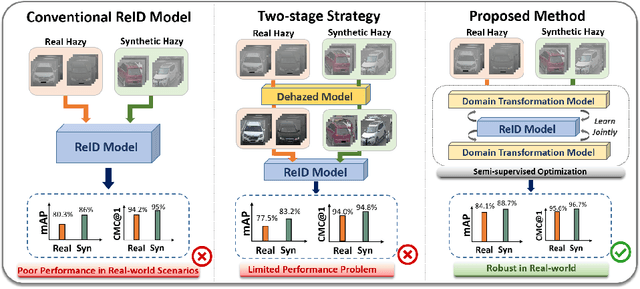

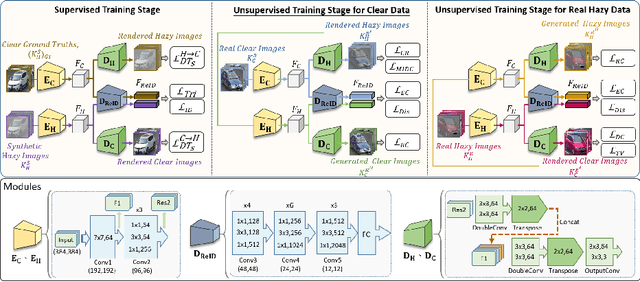
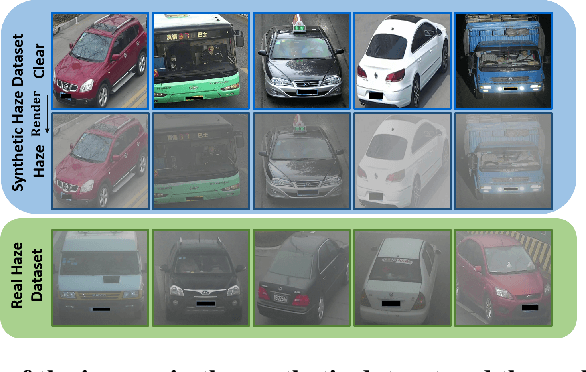
Abstract:Recently, vehicle similarity learning, also called re-identification (ReID), has attracted significant attention in computer vision. Several algorithms have been developed and obtained considerable success. However, most existing methods have unpleasant performance in the hazy scenario due to poor visibility. Though some strategies are possible to resolve this problem, they still have room to be improved due to the limited performance in real-world scenarios and the lack of real-world clear ground truth. Thus, to resolve this problem, inspired by CycleGAN, we construct a training paradigm called \textbf{RVSL} which integrates ReID and domain transformation techniques. The network is trained on semi-supervised fashion and does not require to employ the ID labels and the corresponding clear ground truths to learn hazy vehicle ReID mission in the real-world haze scenes. To further constrain the unsupervised learning process effectively, several losses are developed. Experimental results on synthetic and real-world datasets indicate that the proposed method can achieve state-of-the-art performance on hazy vehicle ReID problems. It is worth mentioning that although the proposed method is trained without real-world label information, it can achieve competitive performance compared to existing supervised methods trained on complete label information.
ContourletNet: A Generalized Rain Removal Architecture Using Multi-Direction Hierarchical Representation
Nov 25, 2021
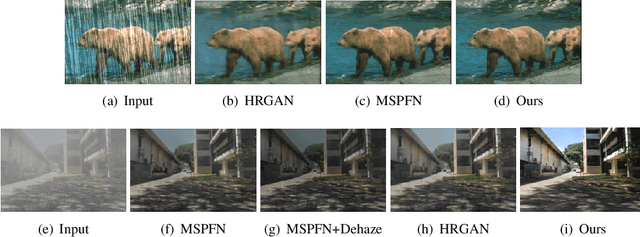

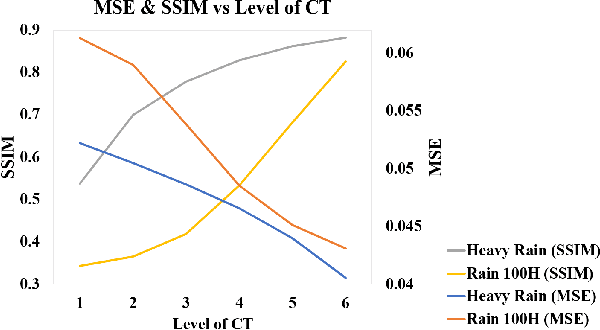
Abstract:Images acquired from rainy scenes usually suffer from bad visibility which may damage the performance of computer vision applications. The rainy scenarios can be categorized into two classes: moderate rain and heavy rain scenes. Moderate rain scene mainly consists of rain streaks while heavy rain scene contains both rain streaks and the veiling effect (similar to haze). Although existing methods have achieved excellent performance on these two cases individually, it still lacks a general architecture to address both heavy rain and moderate rain scenarios effectively. In this paper, we construct a hierarchical multi-direction representation network by using the contourlet transform (CT) to address both moderate rain and heavy rain scenarios. The CT divides the image into the multi-direction subbands (MS) and the semantic subband (SS). First, the rain streak information is retrieved to the MS based on the multi-orientation property of the CT. Second, a hierarchical architecture is proposed to reconstruct the background information including damaged semantic information and the veiling effect in the SS. Last, the multi-level subband discriminator with the feedback error map is proposed. By this module, all subbands can be well optimized. This is the first architecture that can address both of the two scenarios effectively. The code is available in https://github.com/cctakaet/ContourletNet-BMVC2021.
Nonconvex Approach for Sparse and Low-Rank Constrained Models with Dual Momentum
Jun 06, 2019



Abstract:In this manuscript, we research on the behaviors of surrogates for the rank function on different image processing problems and their optimization algorithms. We first propose a novel nonconvex rank surrogate on the general rank minimization problem and apply this to the corrupted image completion problem. Then, we propose that nonconvex rank surrogates can be introduced into two well-known sparse and low-rank models: Robust Principal Component Analysis (RPCA) and Low-Rank Representation (LRR). For optimization, we use alternating direction method of multipliers (ADMM) and propose a trick, which is called the dual momentum. We add the difference of the dual variable between the current and the last iteration with a weight. This trick can avoid the local minimum problem and make the algorithm converge to a solution with smaller recovery error in the nonconvex optimization problem. Also, it can boost the convergence when the variable updates too slowly. We also give a severe proof and verify that the proposed algorithms are convergent. Then, several experiments are conducted, including image completion, denoising, and spectral clustering with outlier detection. These experiments show that the proposed methods are effective in image and signal processing applications, and have the best performance compared with state-of-the-art methods.
Occluded Face Recognition Using Low-rank Regression with Generalized Gradient Direction
Jun 06, 2019



Abstract:In this paper, a very effective method to solve the contiguous face occlusion recognition problem is proposed. It utilizes the robust image gradient direction features together with a variety of mapping functions and adopts a hierarchical sparse and low-rank regression model. This model unites the sparse representation in dictionary learning and the low-rank representation on the error term that is usually messy in the gradient domain. We call it the "weak low-rankness" optimization problem, which can be efficiently solved by the framework of Alternating Direction Method of Multipliers (ADMM). The optimum of the error term has a similar weak low-rank structure as the reference error map and the recognition performance can be enhanced by leaps and bounds using weak low-rankness optimization. Extensive experiments are conducted on real-world disguise / occlusion data and synthesized contiguous occlusion data. These experiments show that the proposed gradient direction-based hierarchical adaptive sparse and low-rank (GD-HASLR) algorithm has the best performance compared to state-of-the-art methods, including popular convolutional neural network-based methods.
Discrete Gyrator Transforms: Computational Algorithms and Applications
Jun 03, 2017



Abstract:As an extension of the 2D fractional Fourier transform (FRFT) and a special case of the 2D linear canonical transform (LCT), the gyrator transform was introduced to produce rotations in twisted space/spatial-frequency planes. It is a useful tool in optics, signal processing and image processing. In this paper, we develop discrete gyrator transforms (DGTs) based on the 2D LCT. Taking the advantage of the additivity property of the 2D LCT, we propose three kinds of DGTs, each of which is a cascade of low-complexity operators. These DGTs have different constraints, characteristics, and properties, and are realized by different computational algorithms. Besides, we propose a kind of DGT based on the eigenfunctions of the gyrator transform. This DGT is an orthonormal transform, and thus its comprehensive properties, especially the additivity property, make it more useful in many applications. We also develop an efficient computational algorithm to significantly reduce the complexity of this DGT. At the end, a brief review of some important applications of the DGTs is presented, including mode conversion, sampling and reconstruction, watermarking, and image encryption.
* Accepted by IEEE Transactions on Signal Processing
 Add to Chrome
Add to Chrome Add to Firefox
Add to Firefox Add to Edge
Add to Edge